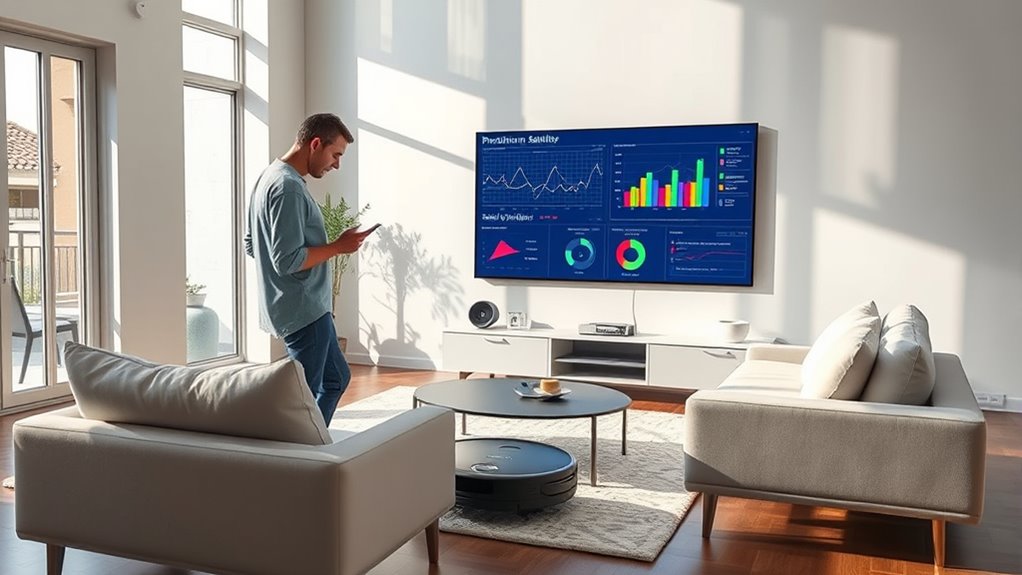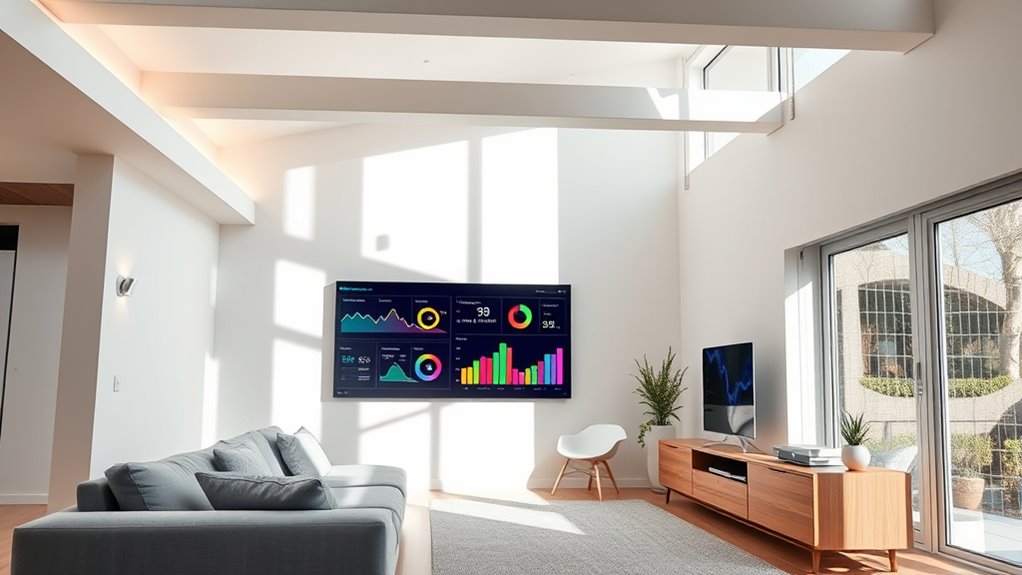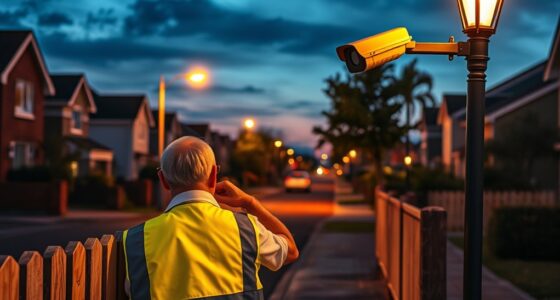Predictive analytics and AI are revolutionizing your home by proactively spotting hazards, optimizing energy use, and enhancing security. Smart systems monitor environmental changes, recognize danger patterns, and alert you immediately or take preventive measures, like shutting off gas or water. They also analyze your routines to guarantee lighting and safety measures are just right. Staying ahead of potential problems keeps your home safer and more efficient. Continue to explore how these innovations can transform your living space.
Key Takeaways
- AI-driven sensors detect hazards like smoke, gas, or water leaks, enabling immediate alerts and preventative actions.
- Predictive analytics forecast maintenance needs, reducing unexpected failures and enhancing home safety.
- Facial recognition and behavior analysis monitor for suspicious activity, providing real-time security updates.
- Automated systems optimize lighting, heating, and appliances based on routines, improving safety and energy efficiency.
- Integration of AI enhances overall home resilience, proactively addressing risks and creating safer living environments.

In today’s home design industry, predictive analytics and artificial intelligence are transforming how you plan and personalize spaces. These technologies help you create safer, smarter environments that adapt seamlessly to your needs. One of the most noticeable changes is in smart lighting systems. Using AI, your home can automatically adjust lighting levels based on your habits, time of day, or even your mood. For example, if you typically read in the evening, the system can prepare the perfect lighting without you lifting a finger. Smart lighting not only enhances comfort but also boosts energy efficiency, reducing unnecessary electricity use. By analyzing your routines, AI ensures lights are on only when needed, saving you money and lowering your carbon footprint. Moreover, home furnishings like heated mattress pads are now integrated into smart home ecosystems, allowing for remote control and personalized comfort settings via apps.
AI-driven lighting adapts to your routines, boosting comfort and energy efficiency effortlessly.
Predictive analytics further enhances safety by identifying potential hazards before they become serious issues. For instance, sensors integrated into your home can monitor for unusual activity or environmental changes, such as smoke, gas leaks, or water leaks. These sensors feed data into AI algorithms that can recognize patterns indicating danger. When a risk is detected, the system can alert you immediately or even take preventative action, like shutting off water valves or turning on exhaust fans. This proactive approach minimizes damage and keeps your home and loved ones safe.
In addition, AI-powered security systems use facial recognition and behavior analysis to monitor who is on your property. You get real-time updates if someone unfamiliar enters or if suspicious activity is detected. This instant feedback helps you respond quickly, whether that means alerting authorities or simply checking your smartphone. Furthermore, predictive analytics can help you maintain your home’s infrastructure. By analyzing data from HVAC systems, plumbing, and electrical components, AI can forecast when maintenance is needed, reducing the likelihood of breakdowns or emergencies. This proactive maintenance not only enhances safety but also extends the lifespan of your home’s systems.
Incorporating AI and predictive analytics into your home design doesn’t mean sacrificing simplicity; rather, it makes your space smarter and more responsive. These tools empower you to anticipate issues before they arise, optimize energy use, and create a safer environment for everyone. As these technologies become more accessible, you’ll find that your home becomes a dynamic space that adapts to your lifestyle while prioritizing safety and efficiency. With AI guiding your design choices, you gain peace of mind knowing your home is not only beautiful but also resilient and secure.
Frequently Asked Questions
How Does AI Improve Safety in Home Construction Processes?
You might wonder how AI improves safety in home construction. It uses smart sensors to monitor the site continuously, providing real-time data. These sensors detect hazards like structural weaknesses or unsafe conditions early, helping you address them before accidents happen. This hazard detection capability allows you to act quickly, reducing risks and ensuring a safer building environment throughout the construction process.
Can Predictive Analytics Prevent Future Home Accidents?
Imagine if Einstein had access to predictive analytics—wouldn’t he have prevented some of his home risk errors? Today, you can use this tech for accident prevention, analyzing data to spot patterns and predict potential hazards. By identifying home risk factors early, predictive analytics helps you take proactive steps, reducing the chance of accidents before they happen. It’s a smart way to keep your home safer for everyone.
What Privacy Concerns Arise With AI in Home Design?
When AI is used in home design, privacy concerns become significant. You might worry about data security, as your personal information and preferences are stored and analyzed. It’s essential that companies obtain your clear user consent before collecting data. Without proper safeguards, your sensitive details could be vulnerable to breaches or misuse. Always guarantee that your privacy is protected and that you’re fully aware of how your data is being used.
How Affordable Is Implementing AI Safety Features at Home?
Think of AI safety features as a sturdy shield for your home’s future. While the initial cost analysis might seem steep, prices are dropping as technology advances, making it more accessible. You’ll find user accessibility improving, too—intuitive interfaces mean you don’t need to be a tech wizard. Over time, investing in these features can save money by preventing accidents and ensuring your home adapts seamlessly to your needs.
Are There Legal Regulations for AI Use in Home Safety?
You should know that legal regulations for AI use in home safety are evolving, and it’s essential to stay compliant. You’re responsible for understanding legal compliance and liability concerns associated with AI systems. Regulations vary by region, and manufacturers often provide guidelines. By ensuring your AI devices meet legal standards, you reduce potential liability concerns and protect your home and family from unforeseen legal issues. Stay informed and consult experts to navigate these regulations effectively.
Conclusion
As you embrace the future of home design, remember that while AI predicts safety risks and streamlines your space, it’s your human touch that brings warmth and personality. Technology can analyze data and prevent hazards, but it’s your intuition and creativity that make a house truly a home. In this balance between machine and mind, safety isn’t just about data—it’s about trusting both innovation and your instincts to create a secure, inviting environment.









